
Bats as Dispersers of Plants in the Lowland Forests of Central French Guiana



by
Nancy B. Simmons and Robert S. Voss
Department of Mammalogy
American Museum of Natural History
simmons@amnh.org and voss@amnh.org
and
Scott A. Mori
Institute of Systematic Botany
The New York Botanical Garden
smori@nybg.org
Central French Guiana may be home to as many as 23 bat species that are obligate or predominant frugivores (Appendix I), and an additional 29 bat species that are known or suspected opportunistic frugivores (Appendix II).
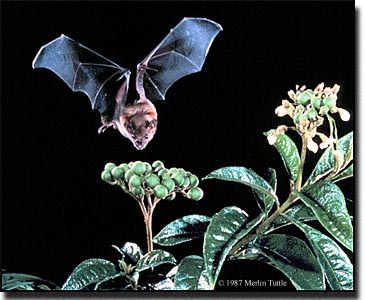 |
|
The bat, Sturnira lilium, approaching the fruits of Solanum rugosum in central French Guiana. Photographed by Dr. Merlin Tuttle of Bat Conservation International in 1987. |
Over 1861 species of flowering plants (426 species of monocots and 1435 species of dicots) comprise the known flora (Mori & Brown, 1998; Mori et al., 1997, in review). Bats play an important role in pollination as well as in the dispersal of flowering plants (Gardner, 1977). A large range of putative bat-dispersed fruits are available to the bat community in central French Guiana: fleshy, berry-like fruits with relatively small seeds [e.g., Solanum (15 spp.) and Vismia (5 spp.)]; figs with small seeds [Ficus (10 spp.)], relatively slender spike-like aggregates of fruits [e.g., Cecropia (2 spp.) and Piper (32 spp.)]; robust spike-like aggregates of fruits [e.g., species of Cyclanthaceae (7 spp.) and Philodendron (22 spp), see Cockle, 1997]; large-seeded fruits surrounded by a more-or-less fleshy pulp [e.g., Dipteryx odorata, Licania spp. (19 spp.), and Spondias mombin); dehiscent fruits opening to expose seeds subtended by fleshy arils [e.g., Lecythis zabucajo and related species]; and an entire fruit subtended by a fleshy, expanded pedicel [e.g., Anacardium spruceanum].
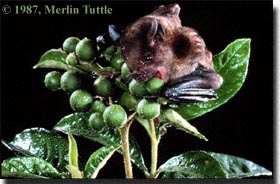
The bat, Sturnira lilium, selecting a fruit of Solanum |
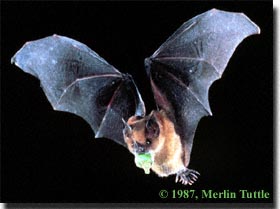
The bat, Sturnira lilium, flying away with a fruit of |
Bats are essential for the recolonization of plants into large gap areas because the seeds they disperse are often from plants adapted for growth in disturbed areas. The fruits of these early colonizers are usually fleshy and contain numerous, small seeds. The bats ingest the fruits, digest the pulp surrounding the seeds, and then defecate the seeds. Seed retention time within bats is often less than 20 minutes and the bats often defecate the seeds while in flight. The seeds of such plants as Cecropia, Solanum, and Vismia are adapted for dispersal by bats and are often the first plants to colonize large open areas. A plastic sheet placed in the middle of one of these fields and checked for seeds periodically reveals that scarcely any seeds arrive during the day whereas there is a steady "seed rain" during the night. Moreover, observation with a night vision scope reveals that bats actively consume the fruits of those species of plants that first invade large gaps.
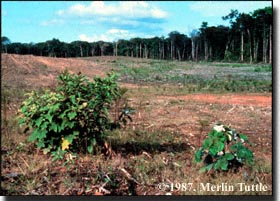 Early secondary succession in a large clearing in central French Guiana. Bats are responsible for dispersing the seeds of these plants, Solanum sp. (left) and Cecropia obtusa (right). Photographed by Dr. Merlin Tuttle of Bat Conservation International in 1987. |
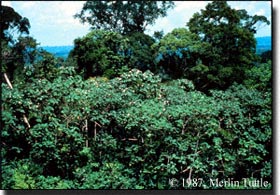 Several years after disturbance, this area in French Guiana has been recolonized by a bat-dispersed species of Cecropia. Conditions are now favorable for invasion by plants dispersed by other means, e.g., by birds and terrestrial mammals. Photographed by Dr. Merlin Tuttle of Bat Conservation International in 1987. |
Once the plants dispersed by bats are in place, the conditions then become favorable for other seed dispersers such as birds and terrestrial mammals to bring the seeds of plants they transport into the area. After about 100 years, a large disturbed area will regenerate to the point that it is structually indistinguishable from pristine areas. It will, however, take a much longer time for the reestablishment of the high species diversity found in areas not recently affected by major disturbance. Remove bats from the ecosystem and regeneration of tropical forests after large-scale disturbance will take much longer.
A long-term goal of our bat/plant research in central French Guiana is to provide information about what plants are dispersed by what bats and what bats are dispersers of plants. Preliminary lists of obligate (Appendix I) and opportunistic (Appendix II) frugivores (fruit-eating animals) have already been prepared based on a comparison of the bats known to occur at Paracou (Simmons & Voss, 1998) and Arataye (Voss & Emmons, 1996), French Guiana with information about bat dietary preferences in Gardner (1977). A list of plants known to be dispersed by bats is under preparation.
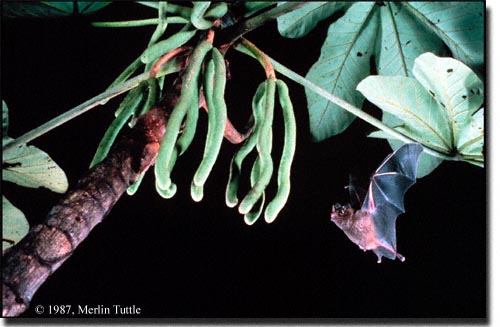 |
| The bat, Carollia perspicillata, approaching the fruits of Cecropia obtusa in French Guiana. Photographed by Dr. Merlin Tuttle of Bat Conservation International in 1987. |
Literature Cited
Cockle, A. 1997. Modalités de dissémination et d'etablissement de lianes de sous-bois (Cyclanthaceae et Philodendron) en forêt. Thèse de Doctorat de l'Université Paris 6.
Gardner, A. L. 1977. Feeding habits. Pages 293-350 in R. J. Baker, J. K. Jones & D. C. Carter (eds.), Biology of bats of the New World family Phyllostomatidae. Part II. Spec. Publ. Mus. Texas Tech. Univ., Lubbock.
Mori, S. A. & J. L. Brown. 1998. Epizoochorous dispersal by barbs, hooks, and spines in a lowland moist forest in central French Guiana. Brittonia 50(2): 165-173.
Mori, S. A., G. Cremers, C. Gracie, J.-J. de Granville, M. Hoff & J. D. Mitchell. 1997. Guide to the vascular plants of central French Guiana. Part 1. Pteridophytes, gymnosperms, and monocotyledons. Mem. New York Bot. Gard. 76(1): 1-422.
Mori, S. A., G. Cremers, C. Gracie, J.-J. de Granville, S. V. Heald & J. D. Mitchell. In review. Guide to the vascular plants of central French Guiana. Part 2. Dicotyledons. Mem. New York Bot. Gard. 76(2): 000-000.
Simmons, N. B. & R. S. Voss. 1998. The mammals of Paracou, French Guiana: A Neotropical lowland rainforest fauna. Part 1. Bats. Bull. Amer. Mus. Nat. Hist. 237: 1-219.
Voss, R. S. & L. H. Emmons. 1996. Mammalian diversity in Neotropical lowland rainforests: a preliminary assessment. Bull. Amer. Mus. Nat. Hist. 230: 1-115.